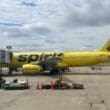Its no secret that Spirit Airlines has had a rough couple of years. The airline has been hemorrhaging cash and recently declared and exited bankruptcy. There’s now a new update, though it isn’t good for the company.
Spirit Airlines Has “Substantial Doubt” Regarding Its Ability to Continue Operations
On August 11, 2025, Spirit Aviation Holdings, Inc., the parent company of Spirit Airlines, filed its 10Q report for the second quarter of 2025. This report, filed with the Securities and Exchange Commission (SEC), indicated that “there is substantial doubt as to the Company’s ability to continue as a going concern within 12 months from the date these financial statements are issued.”

According to the filing, Spirit has taken multiple measures to bolster its financial situation. The ultra-low-cost carrier (ULCC) has sold aircraft, furloughed pilots, and introduced new travel options in an effort to shore up its financial situation. The results of these efforts have been mixed and the airline seems to have confirmed that its turnaround efforts have failed.
As of June 30, 2025, the airline had cash and cash equivalents of $407.5 million with another $275 million available for borrowing. This is a major decline from previous quarterly reports and illustrates just how quickly the airline has been burning through money. At the end of Q1 2025, the carrier had $487.5 million in cash and cash equivalents on hand.
The current financial situation of the airline has put into question the carrier’s ability to meet its minimum liquidity covenants under its credit card processing agreement and debt obligations. If the airline dips below this threshold it would default and cause its debt obligations to be accellerated.
Spirit notes that it is working with its credit card processor to renew its processing agreement, which currently expires on December 31, 2025. While the airline appears hopeful they will be able to come to an agreement, further collateral would be required, the airline also acknowledges that “the level of collateral required to be posted could result in a material reduction of unrestricted cash.”
Whether or not the airline and its credit card processor are able to come to an agreement remains to be seen. However, it does highlight just how precarious the airline’s financial situation is.

Are Regulators to Blame for Spirit’s Downfall?
It’s easy to sit back and play Monday morning quarterback, but part of me feels like regulators are to blame here. Early last year a judge sided with the United States Department of Justice (DOJ) and blocked a proposed merger between Spirit and JetBlue.
The court ruled that a merger between the two carriers was a violation of the Clayton Act and JetBlue, which has had financial woes of its own, was forced to pay Spirit $69 million since the deal wasn’t able to close on regulatory grounds.
This no doubt put Spirit in an even more precarious financial situation and it ended up declaring bankruptcy late last year. It appears that the DOJ has learned some lessons from the failed JetBlue/Spirit merger as it approved the merger between Alaska Airlines and Hawaiian Airlines without so much as a second glance.

What Happens Next?
While Spirit has stated that there is substantial doubt regarding its ability to continue operations, it appears that the carrier has no plans on shutting down. The airline notes in its regulatory filing that its condensed consolidated financial statements have been prepared assuming that it will continue to operate.
At this point a merger seems off the table as Spirit rejected Frontier’s takeover bid multiple times and United and JetBlue have cozied up to one another. The airline does have a significant presence at major airports across the country along with a relatively new fleet of Airbus A320 family aircraft.
It would appear that the most logical option, if the carrier intends to continue operations, is to shrink in size and sell off some of its assets in order to raise cash.
Unfortunately for Spirit, passengers have indicated that they prefer a more premium experience and are willing to pay for it. Pre-pandemic ULCCs like Spirit were dominating the market and forced legacy airlines to make changes to compete. Basic Economy fares made their way to the Big 3 U.S. carriers in an effort to compete with airlines like Spirit, Frontier, and Allegiant.
Now, with the shift in consumer demand, the airline has been struggling to readjust its market position but it may be a victim of its earlier success. When you see those bright yellow planes you think low cost and a lot of ancillary fees. Preferences have shifted away from that model and, while the airline may offer a decent product, I still don’t see a path to profitability.

Summary
Spirit Airlines released its Q2 2025 quarterly 10Q filing and has indicated that there is substantial doubt that it will be able to continue operations over the next twelve months. The airline exited Chapter 11 Bankruptcy earlier this year but has been unable to turn a profit as it continues to burn through cash.
It is unclear what other options are available to the airline in order to improve its financial situation but a merger or liquidation seem like the the most viable options.






